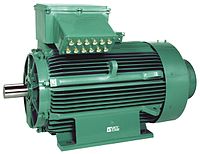
Photo from wikipedia
Split-phase motor drives have advantages such as lower torque ripple, enhanced fault tolerance, higher power-to-weight ratio, and lower dc-link voltage requirement, making it an attractive alternative to the conventional three-phase… Click to show full abstract
Split-phase motor drives have advantages such as lower torque ripple, enhanced fault tolerance, higher power-to-weight ratio, and lower dc-link voltage requirement, making it an attractive alternative to the conventional three-phase drives. In the proposed series-connected topology, both the motors are connected in different phase sequences, allowing the fundamental component of the winding current to produce torque in the first machine, and sixth-order harmonic currents to produce torque in the other machine. Both the motors used are synchronous machines, which have advantages such as higher power density and easier control. The proposed method can be easily extended to other synchronous machines such as permanent magnet machines and reluctance machines. In this article, a mathematical model for series-connected split-phase synchronous motors is developed and validated experimentally for decoupled field-oriented control of dual split-phase synchronous machines. Furthermore, the developed model (series-connected system) is extended for open-circuit fault operation, and experimental results are presented for the first time. Simulation results as well experimental results for steady state, transient conditions for normal, and fault operation are presented to validate the proposed scheme.
Journal Title: IEEE Transactions on Industry Applications
Year Published: 2020
Link to full text (if available)
Share on Social Media: Sign Up to like & get
recommendations!